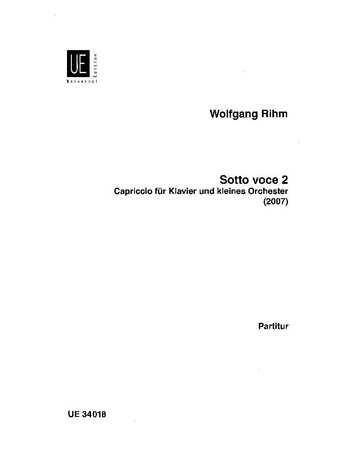.png)
Payments:
Shipping:
Wolfgang Rihm
Rihm: Sotto voce 2 - Capriccio, für Klavier und kleines Orchester
UE34018
Type: Dirigierpartitur
Format: 297 x 420 mm
Pages: 52
Payments:
Shipping:
Audio preview
Description
Giving the world premiere of a new piece is always a challenge, and sometimes a joy. That of Wolfgang Rihm’s Sotto voce 2 was both.
In terms of purely technical challenge, there is nothing in the piece to frighten a pianist who has mastered Chopin’s Etudes, and only a few to frighten the Mozartian. That is not the point, of course. The musical challenges are many, perhaps most of all for any pianist who still believes music goes in reasonably straight lines – in other words one who has not already fully digested the music of the 20th Century.
What piano concerti from before 1900 have a form as improvisatory, complex and subtle as this piece? Which other piano concerto has such an extraordinary variety of material, so artfully interwoven and developed? How many piano concerti have been written with such a clear and profound understanding of earlier repertoire? And then for the pianist there is the delicacy of a relationship with an orchestral palette that seems to hover between the 18th and 20th Centuries…
After its simple antiphonal opening the form of Sotto voce 2 is spontaneous, free-flowing, almost a “stream of consciousness”. New material appears constantly, its striking harmonic colours echoing both the disturbing shadows of late Busoni and the healthier sunlight of his beloved Mozart. Both soloist and orchestra toy with the material freely, and yet with balletic poise. As this game approaches its climax the composer forces the dialogue into a darker corner, lit by nightmare memories. The nightmare dissolves into a joke: a capricious ending to a piece which earns its subtitle – capriccio – easily.
Rihm has not specified metronome marks, so the first question is - how Allegro is Allegro misterioso e capriccioso? Tempo relationships between the sections (most of which are different “flavours” of Allegro) are also not metronomically defined so the interpreter must search within the music itself for the answers. But beyond these fundamental questions of tempo, the musical situation begs many others. In a piece that can move between stylistic areas in an instant, how can one be sure of the expressive style required of the performer? With such formal fluidity, is it desirable or even possible to unify the form in performance? Does the material invite or even demand integration? On the other hand, does the range of materials employed, and its fractured nature, deny or challenge such integration? These questions can only be addressed through the experience brought by multiple performances.
At each contact Sotto voce 2 appears more beautiful, and my affection for it increases. It was a joy to meet the piece’s challenges with my friend Tito Ceccherini and the Haydn Orchestra of Bolzano and Trento, in the beautiful landscape of Erl; and I look forward to continuing my relationship with the piece with the Lucerne Symphony Orchestra and in many other future performances. I hope that the competitors at the Busoni Competition will find as much joy in the challenges as I do.
© Nicolas Hodges
More information
Type: Dirigierpartitur
Format: 297 x 420 mm
Pages: 52

